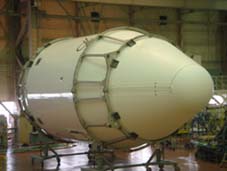Kawasaki Delivers Fairing for H-IIA F11 Launch Vehicle
Nov. 13, 2006

| Tokyo, November 13, 2006 — Kawasaki Heavy Industries, Ltd. announced today that it has shipped a payload fairing*1 for the H-IIA No.11 (H-IIA F11) launch vehicle to the Tanegashima Space Center of the Japan Aerospace Exploration Agency (JAXA). Designed and manufactured at the Gifu Works and shipped from the Harima Works, the fairing will be installed on the H-IIA F11 launch vehicle, which is scheduled for launch on December 16, 2006. The fairing is 5 m in diameter with a single cover (5S), into which a large satellite will be installed. The fairing is large enough for satellites like those carried by the U.S. space shuttle or the European Ariane V. The H-IIA F11 launch vehicle will carry the Engineering Test Satellite VIII (ETS-VIII*2) into space. Kawasaki is responsible for the development and manufacture of the fairing and the payload adapter, which separates the satellite from the launch vehicle. Kawasaki has developed and manufactured various types of payload fairings for H-IIA launch vehicles that can meet a wide range of launch needs including the launch of a large satellite or the simultaneous launch of two satellites. Kawasaki will continue to make active contributions to Japan’s satellite launch service through the development and manufacture of fairings. *1: A payload fairing is a cover installed at the tip of a launch vehicle to protect the satellite from aerodynamic heating and vibration during liftoff. After the launch vehicle leaves the earth’s atmosphere, the fairing splits in two and is jettisoned, allowing the satellite to separate from the launch vehicle. *2: ETS-VIII is the eighth engineering test satellite developed by JAXA with an objective of demonstrating mobile satellite communication system technology that will enable audio/data communications with hand-held terminals. The satellite is equipped with two large-scale deployable antennas to make a tennis-court-size parabola by expanding its modules. The ETS-VIII employs Japan’s first three-ton-class geostationary satellite bus. |





